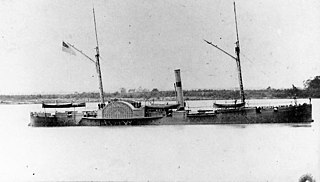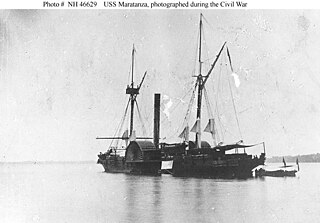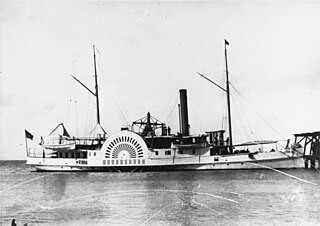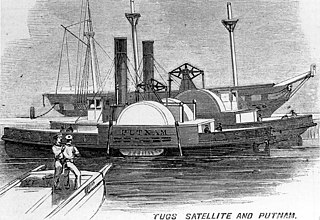
USS Advance, the second United States Navy ship to be so named, was later known as USS Frolic, and was originally the blockade runner Advance captured by the Union Navy during the latter part of the American Civil War. She was purchased by the Union Navy and outfitted as a gunboat and assigned to the blockade of the waterways of the Confederate States of America. She also served as dispatch ship and supply vessel when military action eventually slowed.

USS Richmond was a wooden steam sloop in the United States Navy during the American Civil War.

USS Marblehead was a Unadilla-class gunboat built for the United States Navy during the American Civil War.
USS Dacotah – the only United States Navy ship to be so named – was a large steam sloop that served the United States Navy in the Atlantic Ocean as well as in the Pacific Ocean. When the American Civil War occurred, Dacotah assumed the role of a gunboat in the Union blockade of the Confederate States of America.

USS Conemaugh was a side-wheel steamer in the United States Navy during the American Civil War. With her large crew of 125 and her powerful guns, she was assigned as a gunboat on the Union blockade of the Confederate States of America.
The first USS Chocura was a Unadilla-class gunboat which saw service with the U.S. Navy during the American Civil War.

USS Albatross was a screw steamer rigged as a three-masted schooner acquired by the Union Navy during the beginning of the American Civil War. She was outfitted as a gunboat with heavy guns and used in the Union blockade of the waterways of the Confederate States of America.

The first USS Cimarron was a sidewheel double-ended steam gunboat of the United States Navy that served during the American Civil War.

USS Unadilla was a Unadilla-class gunboat built for service with the United States Navy during the American Civil War. She was the lead ship in her class.

USS Maratanza was a steamer acquired by the Union Navy during the American Civil War. She was used by the Union Navy as a gunboat to patrol navigable waterways of the Confederacy to prevent the South from trading with other countries.

USS Delaware was a steamer acquired by the Union Navy for use during the American Civil War. She had a very active naval career as a gunboat for over three years, and after the war served as a revenue cutter for over 37 years. The steamer was sold to the private sector in 1903, and disappeared from shipping registers in 1919.

USS General Putnam – also known as the USS William G. Putnam – was acquired by the Union Navy during the first year of the American Civil War and outfitted as a gunboat and assigned to the Union blockade of the Confederate States of America. She also served as a tugboat and as a ship's tender when so required.

The USS Daylight was a steamship acquired by the Union Navy during the American Civil War. She was used by the Navy to patrol navigable waterways of the Confederacy to prevent the South from trading with other countries.

The first USS Dawn was a steam-operated vessel acquired by the Union Navy during the American Civil War. She was used by the Navy to patrol navigable waterways of the Confederacy to prevent the South from trading with other countries.
USS Western World was a ship acquired by the Union Navy during the American Civil War. She was used by the Navy to patrol navigable waterways of the Confederacy to prevent the South from trading with other countries.

USS Octorara was a steamer acquired by the Union Navy during the American Civil War. She was used by the Navy to patrol navigable waterways of the Confederacy to prevent the Confederates from trading with other countries.
USS Dan Smith was a schooner used by the Union Navy during the American Civil War. She was used by the Navy to patrol navigable waterways of the Confederacy to prevent the South from trading with other countries.

USS Thomas Freeborn was a steam tug acquired by the Union Navy during the American Civil War. She was used by the Navy as a gunboat to patrol navigable waterways of the Confederacy to prevent the South from trading with other countries.
USS Victoria was a steamer acquired by the Union Navy during the American Civil War.
USS Wyandotte, originally USS Western Port, was a steamer acquired by the Navy as a gunboat for the Paraguay expedition in 1858. When the crisis of the American Civil War occurred, she operated in support of the Union Navy blockade of Confederate waterways.















